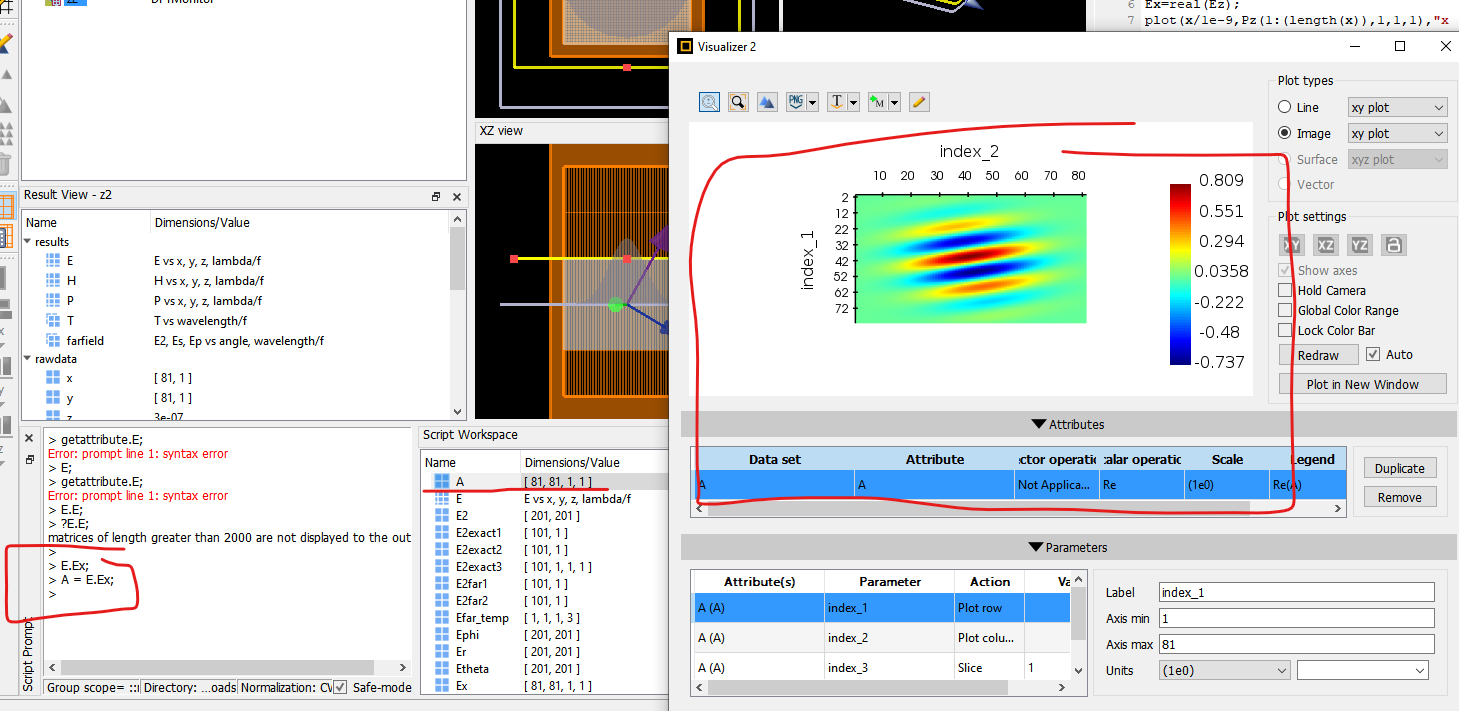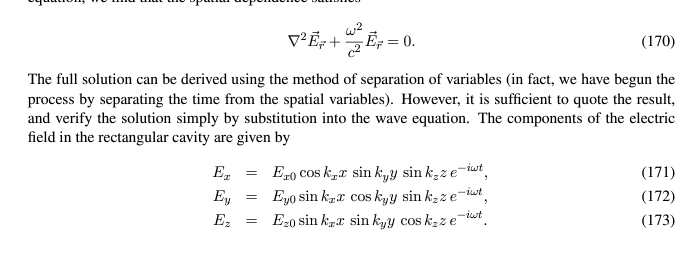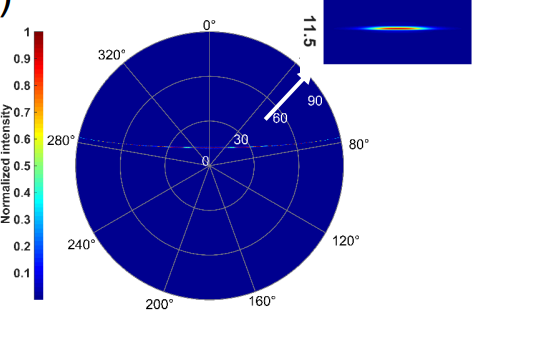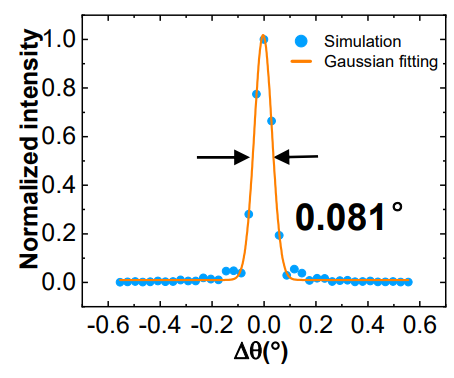TAGGED: far-field, Lumerical-FDTD
-
-
December 11, 2023 at 10:40 am
Chenxi Ma
SubscriberI would like to calculate the complex electric field of the far field, which means that besides the amplitude distribution, I also want to analyze the phase/wavefront information.
However, I only know one way to calculate the electric field amplitude: E = sqrt(abs(Ex)^2+abs(Ey)^2+abs(Ez)^2). But the complex values are not preserved anymore.
Could someone kindly teach me how to calculate the complex electric field amplitude using Ex, Ey, and Ez? Thanks a lot in advance!
P.S. Ex, Ey, and Ez are complex values from a monitor. -
December 11, 2023 at 3:38 pm
Dimitris Polyzos
Ansys EmployeeHello ,
You can use either of the fowolling script commadns to get the complex electric field components in the farfield region:
The difference between them is that farfieldpolar3d returns the results in the spherical coordinates (Er,Eθ,Eϕ), while farfieldexact3d returns the fields in Cartesian co-ordinates (Ex,Ey,Ez). Also for farfieldpolar3d the fields are projected to a hemisphere 1 m away while in farfieldexact3d, you can specify the plane over which the fields are to be projected by directly specifying the x,y, and z coordinates of the plane as input.
I hope I helped. PLease let me know if you need further help.
Kind regards
Dimitirs
-
December 11, 2023 at 4:03 pm
Chenxi Ma
SubscriberHi Dimitirs, thank you very much for your kind reply. I'm using farfieldexact3d. However, it outputs a multi-dimensional dataset with individually saved Ex, Ey, and Ez. I'm asking for a method to calculate the complex electric field amplitude using them, similar to the electric field intensity calculation |E|^2 = |Ex|^2 + |Ey|^2 + |Ez|^2. By calculating the squareroot of |E|^2 I get the electric field amplitude, but not the complex amplitude.
-
-
December 11, 2023 at 9:48 pm
Dimitris Polyzos
Ansys EmployeeHi Chenxi,
thanks for your reply. One thing you can do is to click on the Ex, Ey, Ez from the raw data and send it to script, then you can rename it and call it in the script worspace. Please check the pictyure below:
Otherwise you can build ascript structure, as it is depicted in the picture attached below, where you can see the structure of a simple example. I also attach the script.
mon_name="z2";
x=getdata(mon_name,"x");
y=getdata(mon_name,"y");
f=getdata(mon_name,"f");
Ex=getdata(mon_name,"Ex");
Ex=real(Ez);
plot(x/1e-9,Pz(1:(length(x)),1,1,1),"x (nm)","Ex");
I hope I helped. Let me know if you need further help.
kind regards
Dimitris
-
December 11, 2023 at 10:21 pm
Chenxi Ma
SubscriberI appreciate your quick reply. I have access to the raw data of Ex, Ey, and Ez. However, the question is more about how to "combine" them in a physically correct manner to calculate the complex electric field amplitude...
-
-
December 12, 2023 at 8:42 am
Dimitris Polyzos
Ansys EmployeeHello,
I think you should have a look at these script commands that return the complex electric fields instead of the E intensity:
https://optics.ansys.com/hc/en-us/articles/360034930633
https://optics.ansys.com/hc/en-us/articles/360034410114
I hope I helped. Please let me know if you need further assistance
Kind regards
Dimitris
-
December 12, 2023 at 8:48 am
Dimitris Polyzos
Ansys EmployeeHello Chenxi,
Something I missed to add to my previous email is that you can do a post processing analysis after you get the raw data. As I mentioned, and you already did, you obtain the complex valued fields with ‘getdata’ command and then you can manipulate them with scripting using the ‘real’, ‘imag’ and ‘angle’ (phase) commands.
Kind regardsDimitris
-
December 13, 2023 at 1:46 pm
Chenxi Ma
SubscriberI appreciate your help. However individual components of the electric field are not what I want. I'm asking for the correct equation to calculate the combined complex electric field amplitude E, using Ex, Ey, and Ez, which are the individual components. This is more like a question about physics than Lumerical techniques.
-
-
December 14, 2023 at 8:49 am
Dimitris Polyzos
Ansys EmployeeHello Chenxi,
Sorry for the misunderstanding but I thought you would need something related to Lumerical. I reckon you can find the complex equations of E field online and it should be something similar to the following:
I attatch the link to have a look yourself :
I hope I helped.
Kind regards
Dimitris
-
February 25, 2024 at 5:49 pm
21dr0050
SubscriberHow can I get normalized far field intensity for grating at different wavelength from the farfield figure.
-
February 26, 2024 at 8:55 am
Dimitris Polyzos
Ansys EmployeeHello,
I would recommend to have a look at this article: Far-field-projections-in-FDTD-overview.
The results for far field are in V/m and normalized for an input source of 1 V/m. Generally the field strength for far field results can be low, considering the decay over distance. More information can be found in this example as well: Simple far field projection example.
I hope I helped.
Kind regards
Dimitris
-
February 26, 2024 at 5:19 pm
-
- The topic ‘Far-field complex electric field amplitude’ is closed to new replies.


- Difference between answers in version 2024 and 2017 lumerical mode solution
- Errors Running Ring Modulator Example on Cluster
- Import material .txt file with script
- Trapezoidal ring
- Help for qINTERCONNECT
- Absorption cross-section of AuNR excited by prism-based TIR
- Issues with getting result from interconnent analysis script
- Topology Optimization Error
- How to measure transmission coefficients on a given plane .
- Edge Coupler EME Example Issue

-
1932
-
823
-
599
-
591
-
366

© 2025 Copyright ANSYS, Inc. All rights reserved.










